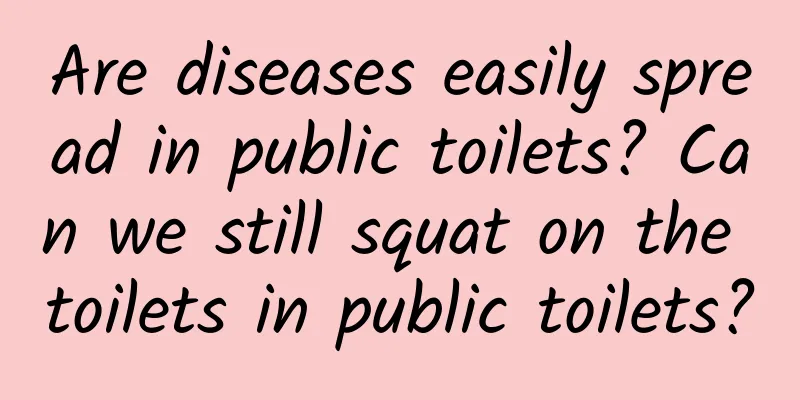Are diseases easily spread in public toilets? Can we still squat on the toilets in public toilets?

|
"Public toilets" have always been a controversial topic. In the early years, some people complained that public toilets were difficult to find. Later, some people suggested that there should be more women's toilets than men's toilets. In the past two years, as many public places have replaced squat toilets with toilets, more and more people have begun to ask: Can toilets in public toilets spread diseases? (After all, we don’t know who just sat on the toilet in the public toilet.) Toilet, Image source: pexels Since everyone is worried about infectious diseases, let's discuss them according to the principles of infectious diseases: first, let's look at what microorganisms may exist in the toilet, then start from their transmission methods, preliminarily infer the size of the infection risk, and finally, talk about how to prevent it. Are there pathogenic microorganisms in public toilets? have. Regarding this matter, we can look at the following two research reports. One of the research reports was published this year. Scholars from Taichung University of Science and Technology and the National University of Singapore randomly selected 61 public toilets in Taiwan, including hospitals, shopping malls, train stations and libraries. The sampling and analysis of them showed that there were indeed pathogenic microorganisms in public toilets, mainly Escherichia coli and Staphylococcus. The other is an earlier research report with a special scope: scholars from the Civil Aerospace Administration of China conducted random inspections on domestic flights. The results showed that toilet seats and toilet seats on airplanes contained a variety of pathogenic microorganisms, such as Escherichia coli, Staphylococcus aureus, Pseudomonas aeruginosa, Acinetobacter baumannii, Clostridium difficile, etc. Do you see any pattern? First, they are all bacteria, and more precisely, most of them are opportunistic pathogens. Second, the Treponema pallidum that causes syphilis, the human immunodeficiency virus that causes AIDS, and the human papillomavirus (HPV) that causes genital warts, which are the most worrying, are not present. On the one hand, these pathogenic microorganisms are relatively fragile and not as resistant to the environment as bacteria; on the other hand, they often need to reach a certain number to break through the human immune barrier. Taking HPV as an example, the American Cancer Society clearly pointed out that it is mainly transmitted through sexual behavior, not through sharing toilets. Ways to avoid HPV transmission, Image source: cancer.org In addition, there may be two pathogenic microorganisms in public toilets: norovirus and new coronavirus. Can pathogens be spread through toilets? Normally not. The human body has natural resistance to Staphylococcus aureus; it only breaks down when the skin and mucous membranes are damaged and the immune system is weakened. In other words, if the skin is damaged, or if you have chronic diseases such as tuberculosis, tumors, diabetes, or are taking immunosuppressants, using the toilet in a public restroom may indeed cause infection. Healthy people do not need to worry about this. Other opportunistic pathogens are similar. Escherichia coli is already present in our bodies, so there is no need to worry unless the immune system is weakened or it has invaded parts other than the large intestine. Pseudomonas aeruginosa is widely present in the soil, so there is no need to worry unless the immune system is weakened. Clostridium is a little special and can invade the human body through food or wounds. Generally speaking, there is nothing to worry about. Can Norovirus be spread through toilets? Norovirus cannot be spread through toilets, but it can be spread in public restrooms. In 2009, Air New Zealand had a Norovirus epidemic. At an altitude of 10,000 meters, 29 flight attendants and 5 passengers suffered from severe vomiting and diarrhea. Subsequent investigations showed that they were infected through indirect contact. What is indirect contact? Norovirus is very common and exists all over the world. Specifically in China, autumn and winter are the peak seasons every year. Its transmission method is very simple, mainly through fecal-oral transmission. When the hands touch objects contaminated with the virus, and then the hands touch the mouth, it is called indirect contact transmission; eating food and water contaminated by feces is called direct transmission. Norovirus mainly attacks the intestines and then enters the environment with the patient's feces. Therefore, we can't just stare at the toilet and ignore other places where dirt is hidden, such as faucets, sink surfaces, mobile phone surfaces, etc. Areas where toilets may be contaminated. Image source: What is the risk of acquiring SARS-CoV-2 from the use of public toilets Can the new coronavirus be transmitted through toilets? The spread of the new coronavirus is a little more complicated. First, the new coronavirus may appear in the toilet. Foreign studies have shown that the virus may be detected in the feces of patients with new coronary pneumonia; in China, the "Diagnosis and Treatment Plan for New Coronavirus Pneumonia (Trial Eighth Revised Edition)" also clearly pointed out that the new coronavirus may exist in feces. Related news, image source: Weibo Secondly, there are three ways of transmission of the new coronavirus: droplet transmission, direct contact with the virus contained in droplets; contact transmission, using hands as a bridge to indirectly contact the surface of objects contaminated by the virus; aerosol transmission, inhalation of aerosols containing the virus. Among them, droplet transmission can occur in any situation where there is close contact with people, regardless of whether it is a toilet or a squat toilet; contact transmission depends on whether there is virus on the surface of objects, whether the hands have touched contaminated areas, and whether the hands have been washed in time, which has nothing to do with whether it is a toilet or a squat toilet; aerosol transmission is the most special and is also the issue that many friends are most concerned about. It is said on the Internet that if the toilet lid is not closed when flushing, the bacteria will be lifted up to 6 meters in the air with the cyclone. Is it true? So, does a squat toilet not need to be flushed? First, flushing can indeed stir up viral particles, but it is not as exaggerated as the rumors online. Second, studies have shown that keeping toilet lids closed and using siphon flushes instead of direct flushes can significantly reduce the presence of aerosols; Third, as long as it is an aerosol, we can use the methods we are familiar with to deal with it, such as adequate ventilation. Summarize At this point, everyone must have understood that whether or not we will contract an infectious disease depends largely on our living habits. Specifically, when entering public places, be sure to wear a mask; try to choose a public toilet that is cleaned promptly and well ventilated; if the toilet has a lid, it is best to cover the lid and flush after using the toilet; of course, the most important thing is to wash your hands promptly and correctly. After washing your hands, it is best to dry your hands with toilet paper and then discard the toilet paper in the trash can. References [1] Li Fan. Medical Microbiology[M]. People's Health, 1976. [2]HPV and Cancer [EB/OL]. [2021-12-23] [3]DANCER SJ, LI Y, HART A, et al. What is the risk of acquiring SARS-CoV-2 from the use of public toilets? [J]. Science of The Total Environment, 2021, 792: 148341. [4]LEE MCJ, THAM KW. Public toilets with insufficient ventilation present high cross infection risk [J]. Scientific Reports, 2021, 11(1): 20623. [5] Xiong Jiasheng, Li Rui, Yu Guorong, et al. Study on the effects of different toilet flushing methods on the characteristics of bacterial communities in toilet air[J]. Modern Preventive Medicine, 2016, 43(13): 2340–2343. [6] Fan Jinhui, Zhou Yujin, Liang Zhaohui, et al. Investigation on the current status of microbial contamination on the surfaces of civil aircraft[J]. Chinese Journal of Disinfection, 2019, 36(06):457-460. [7] National Health Commission of the People's Republic of China. Diagnosis and treatment plan for novel coronavirus pneumonia (trial eighth revised version)[J]. Chinese Journal of Clinical Infectious Diseases, 2021, 14(02):81-88. [8]SCHRECK JH, LASHAKI MJ, HASHEMI J, et al. Aerosol generation in public restrooms[J]. Physics of Fluids, American Institute of Physics, 2021, 33(3):033320. Not long ago, the topic "Playing with mobile phones in the toilet can easily spread diseases" became a hot search. Reminder: It is not advisable to bring your mobile phone to the toilet. Because...If you don't pay attention when using the toilet, it is not only easy to spread diseases, but also easy to cause hemorrhoids... END Tadpole Musical Notation original article, please indicate the source when reprinting Editor/Heart and Paper |
<<: How is it calculated that the expansion speed of the universe exceeds the speed of light?
Recommend
Eight criteria to help you evaluate the quality of UI design works
A complete UI design is actually quite complicate...
How to create an Internet celebrity store through promotion? There are 3 steps to promotion!
Many people have a dream of becoming an internet ...
Xiaohongshu product analysis: useful information to recommend products? Advertising and marketing?
This article will analyze Xiaohongshu from severa...
Wearing a mask will make people sick? It's not that easy!
The COVID-19 pandemic has repeatedly recurred, an...
Robin Li: The mass-produced car will be launched in July next year without a steering wheel and driver's seat
On December 3, the 4th World Internet Conference ...
How much is the price of Nanjing Audition Club? Which one has a better price/performance ratio?
Reservation arrangements for Nanjing audition clu...
This common "birthmark" may be a disease: "coffee spots" that cannot be ignored
Coffee-fronted spots are a common "birthmark...
10 tips for new operations people to help you avoid operations pitfalls!
After I wrote some operation articles in Product ...
Case analysis: How to conduct operational data analysis
The article mainly outlines the methods and proce...
As marketing skills become more popular, how do strategists implement them?
There was once an ultimate question popular in th...
How to do foreign trade promotion: Google bidding promotion or Google optimization?
From the moment you decide to do Google foreign t...
How to write valuable copy?
Copywriting is an important part of brand promoti...
In late autumn, if you want to "rest", you must know these →
Recently, many places in Beijing, which has enter...
Smart home access to mobile customer service professional platform construction is the key
As more and more smart devices are connected to t...









